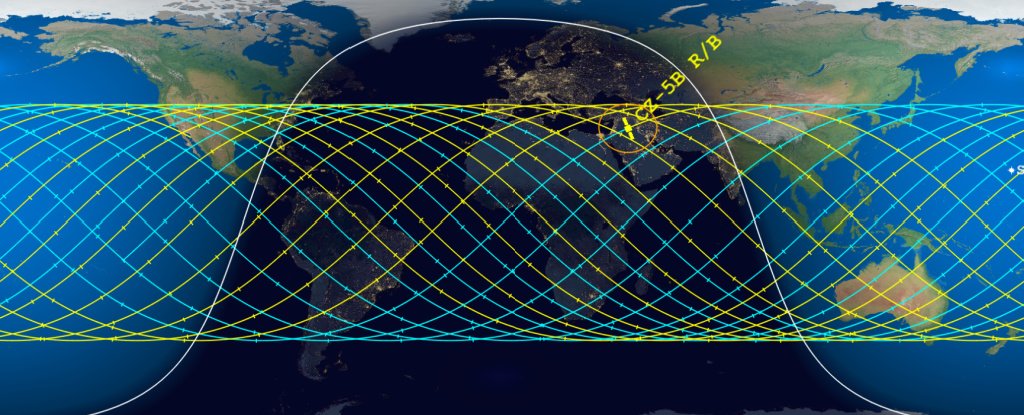Products You May Like
This weekend, a massive, uncontrolled rocket booster is predicted to hurtle back to Earth, with a high chance that at least some of the debris will be large enough to survive the descent and smash into our planet.
The booster is 53.6 meters (176 feet) long and weighs around 23 metric tons, and belongs to a recently launched Chinese rocket.
The good news is, the chances of this latest descent causing significant damage are pretty low. The bad news is that as of now we don’t have a solid idea of where the rocket booster will likely crash.
Researchers around the globe are working hard to figure that part out. So far, they’re pretty sure the reentry will happen on 31 July 2022, and is likely to fall beneath the yellow and blue swirling lines in the map below.
 Reentry predictions as of 27 July 2022. (Aerospace Corporation)
Reentry predictions as of 27 July 2022. (Aerospace Corporation)
Above: Yellow and blue lines show the area of potential reentry. The yellow icon shows where the rocket booster will be at the midpoint of the reentry window, and the orange line shows where the reentry may be visible from.The white line separates the areas that will be in day and night at the midpoint of the reentry window.
“Due to the uncontrolled nature of its descent, there is a non-zero probability of the surviving debris landing in a populated area – over 88 percent of the world’s population lives under the reentry’s potential debris footprint,” the Aerospace Corporation, a company that’s tracking the booster’s reentry, said in a press release this week.
“A reentry of this size will not burn up in the Earth’s atmosphere, and the general rule of thumb is that 20-40 percent of the mass of a large object will reach the ground, though it depends on the design of the object.”
Our latest prediction for #CZ5B rocket body reentry is:
🚀31 Jul 2022 00:24 UTC ± 16 hours
Reentry will be along one of the ground tracks shown here. It is still too early to determine a meaningful debris footprint. Follow this page for updates: https://t.co/SxrMtcJnj0 pic.twitter.com/CZRQBClOAg— The Aerospace Corporation (@AerospaceCorp) July 28, 2022
If this sounds like a familiar scenario, you’re not wrong. Last year, a very similar thing happened – with the resulting debris fortunately landing in the remote Indian Ocean.
However, in 2020, parts of the same make of rocket booster did crash near Africa’s Ivory Coast, sending debris into villages: but still without any recorded major damage.
The rocket booster in question comes from a Long March 5B rocket, which was launched by China’s National Space Administration (CNSA) on 24 July 2022, with the job of delivering a new module into orbit to help build the country’s growing Tiangong space station.
In most rocket launches, the booster helps transport a rocket out of Earth’s atmosphere. It is then the first stage to fall free once the rocket reaches space.
For reusable boosters like the ones famously made by SpaceX, once released they are guided back to the surface intact, ready for another mission.
Boosters commonly used by NASA have typically tumbled back through the atmosphere at the end of a parachute, falling in a predictable zone without ever having entered orbit. These are then scooped up by ships and refurbished.
Material that does reach orbit, such as this particular booster, becomes a little more challenging to track.
Since China’s Long March 5B is so massive, it’s expected roughly 4-9 metric tons could make it back through the atmosphere when the core boosters re-enter.
With that in mind, it’s good to know earlier this week a study came out estimating the chance that someone will be killed of falling space junk over the next decade, and found there’s only a 10 percent likelihood of one or more death.
An analyst for the Aerospace Corporation, Ted Muelhaupt told Reuters that the risk posed to any single individual is on the order of six chances per 10 trillion for any one person.
He also added that 75 percent of the planet’s surface in the potential path of reentry is water, desert, or jungle.
Take care out there this weekend, and if you’re lucky you may even be able to view the booster’s reentry as it hurtles back to Earth from a safe distance.
